F900R test: the completely revised BMW roadster … with a dejà vu R
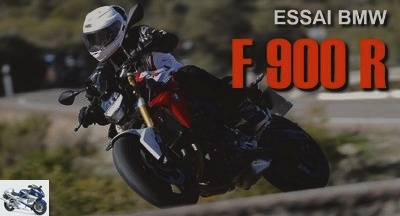
BMW has just presented two major 2020 novelties to the international press: the F900R and the F900XR. Honor to the roadster who is embarking on the most popular segment of French bikers and that Site had between the gloves one morning. Quick test, well done !
F900R test page 3: Technical point
Engine
The F900R receives the in-line twin that has been fitted to the F850GS since 2018. Or rather an evolution, otherwise the new BMW Motorrad roadster would have been baptized F850R … Indeed, the displacement of the Twin went from 853 to 895 cc, via an increase in the bore (diameter of the pistons) of 2 mm.
The transition to "nine hundred" is accompanied by an increase in maximum power: 105 horsepower at 8,500 rpm, or 10 hp more than the trail. The maximum value of the engine torque does not increase (92 Nm) but its curve has "been made much more harmonious over the entire speed range", assures the manufacturer, graph in support.
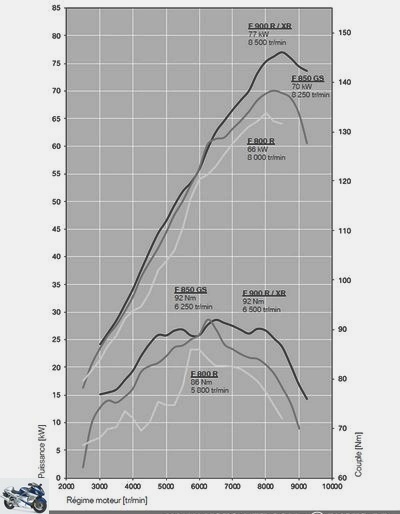
In addition to the increased displacement, the mill – water – of the F900R differs from that of the GS through its redesigned cylinder head in which the compression ratio reaches 13.1: 1. The two overhead camshafts are always chain driven and the eight valves are controlled by "light" pawls and therefore resistant to high revs.
New forged pistons appear (they are cast on the GS), while their crankshaft retains its 90 ° offset crankpins and 270/450 ° timing, thanks to which the F900R must offer "an even more intense and richer sound. in emotions (compared to the F800R stalled at 360 °, Editor’s note), which is similar to a V2 engine at 90 ° ", boasts the Flat Twin specialist…
For acoustics but also for aesthetics, the Munich firm and its partner in Chongqing (the Chinese manufacturer Loncin which manufactures these parallel twin cylinders and sends them to the BMW Motorrad plant in Berlin for assembly of the motorcycle) have equipped the "nine hundred" from a stainless steel pot, low and short.
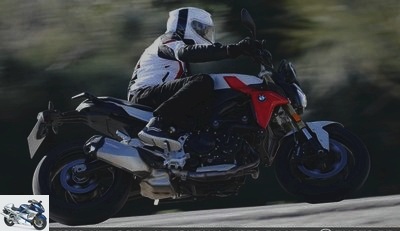
Inside the block, two balance shafts which rotate in the opposite direction to the crankshaft, in front and behind it, have the task of suppressing unwanted vibrations. Still in the lower engine, splash losses and reliability are respectively mitigated and optimized by the dry sump lubrication system which does not have a separate oil tank.
The clutch in oil bath has an anti-slip function which ensures that the engine engine braking is limited during heavy braking and / or rapid downshifts (optional shifter). Second benefit of the system: the left lever (adjustable in spacing, like that of the front brake, on the right) is easier to grip.
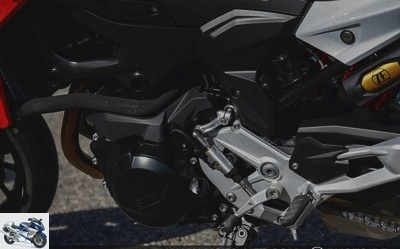
“A slip clutch releases the clutch from a mechanically defined threshold to prevent locking of the rear wheel, specifies BMW.“ If the available grip is below this threshold, for example when the road is wet, the rear wheel may however slip ".
This is why the F900R receives the electronic engine brake regulator (MSR) as standard: "depending on the grip, the butterflies can open in a thousandth of a second to reduce the inertia torque, so that the rear wheel retains its grip ", guarantee the Germans.
Unlike the F800R which developed 87 hp when it was released in 2009 then 90 hp in 2012, the 2020 F900R is not originally eligible for the A2 license. To do this, BMW has planned a version limited to 95 hp (70 kW) therefore restrictable to 48 hp (the famous 35 kW). Attention, "a subsequent change from 95 hp to 105 is not possible", reminds Behème..
Part-cycle
The aluminum frame and swingarm of the F800R give way to an all-steel frame identical to those found in the 750 and 850 GS. As on the trails, the frame of the new roadster is based on the twin cylinder and consists of stamped parts welded together.
The rear loop is specific to the F900R: particularly short, it should lighten the bike and its line. The fixing of the passenger footrests has been modified accordingly: attached to the GS buckle, they are mounted on the supports of the roadster’s rider footrests.
BMW has also returned to the great originality of its F series: the tank housed under the saddle returns to its traditional position. However, the F900R differs from the current GS by its welded plastic tank, "a world first in the motorcycle industry", the Germans boast, also stating that "compared to a comparable steel tank, the weight saving is approximately 60% ".
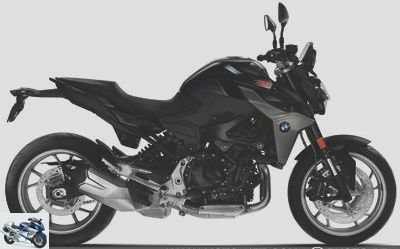
The new F 900 R has an inverted telescopic fork 43 mm in non-adjustable diameter, and a central shock absorber directly attached to the swingarm, adjustable in preload and rebound. Their respective travel are 135 and 142 mm.
Braking is entrusted at the front to a pair of discs with a diameter of 320 mm bitten by Brembo four-piston radial calipers, which "guarantees reliable and foolproof deceleration". The rear wheel has a single 265mm disc, with a single piston floating caliper.
To respond to the sportier program of the roadster, the angle of the steering column and the offset of the triple trees have been revised in relation to the trails. The driving position is also suitable: "as a dynamic roadster, and because of its chassis and ergonomics, the new F900R is primarily dedicated to active and sporty driving on winding roads", considers BMW.
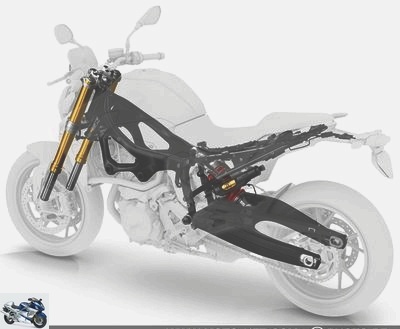
"The ergonomic triangle of the F900R (with the standard saddle) is clearly more dynamic and oriented towards the front wheel more than that of the F800R", beg us to believe the Bavarian brand, supporting figures: "the rests- feet are set 15 mm higher and 5 mm further back, the handlebars are 25 mm further forward ".
"With the high or super-high saddle, the rider’s position is even sportier", specifies BMW, in addition to being more pleasant for tall riders, "the angle of the knees being at the same time more open. MNC has tested and approved model 20mm higher.
Conversely, novices and children who find the original saddle too high (825 mm) will surely appreciate being able to install a lower saddle on their bike, or even order their bike with a lowering kit. to further reduce the height (775 mm). If necessary, customers can also mount a higher handlebar on their roadster. Finally, the two levers are adjustable in spacing. Standard, yes !
Electronic
The F900R receives two driving modes "Rain" and "Road" as standard. The standard equipment also includes ABS (mandatory) and ASC traction control (can be deactivated, but this is of little interest, except for stunters!). In "rain" mode, the throttle response is tempered, ABS and traction control are more responsive.
Two other driving modes "Dynamic" and "Dynamic Pro" are available as options (ex works). They incorporate dynamic brake control (DBC, seconded by MSR), ABS Pro which replaces conventional ABS, as well as dynamic traction control (DTC) which replaces ASC.
As a reminder, the DBC is responsible for deactivating the accelerator (butterflies blocked in the closed position) on the braking phases in order to avoid any false maneuver, especially in the event of a problem. "The motorcycle thus keeps its stability and the braking distance is shortened", guarantees BMW.
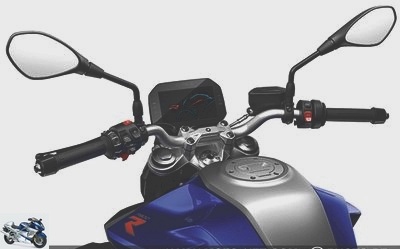
Thanks to the data recorded and communicated by its inertial unit, "the ABS Pro goes even further than BMW Motorrad ABS and provides additional safety when braking in bends, braking assisted by ABS being possible in an inclined position", recalls also BMW to beginner bikers … or from other brands !
The ABS Pro not only takes care of preventing any wheel lock, but also of keeping the rear wheel on the ground. "In ‘Rain’ and ‘Road’ driving modes, ABS Pro is designed for road use with medium to low grip, as well as providing excellent braking stability. Regulation takes place very early.".
"In" Dynamic "driving mode, the ABS Pro is based on road conditions with very good grip. The ABS Pro is adjusted accordingly to allow optimum deceleration, regulation takes place later and detection of rear wheel take-off is reduced ".
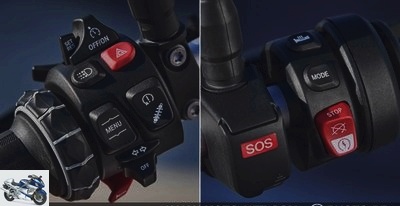
Whatever mode is chosen, the Dynamic brake Light function is activated: the riders following the motorcycle are warned that the rider is performing strong or emergency braking by flashing the brake light, then triggering the hazard warning lights if the speed drops below 14 km / h.
In terms of lighting, the F900R makes full use of LEDs: for its single headlight with low beam and high beam, its rear light and its indicators. To have daytime running lights (LED and fiber optic), you must however select the Headlight Pro option….
This system also integrates – and above all – additional LED modules housed in the base part of the headlight and fitted with reflectors which serve to illuminate the inside of the bends as soon as the motorcycle leans more than 7 ° to one side or the other. ‘other. "The additional (and light, Editor’s note) lighting is optimally visible up to an inclined position of 25 °", BMW calculated.
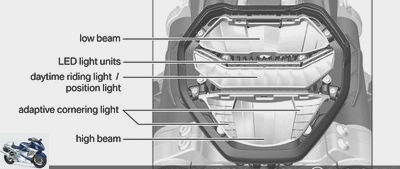
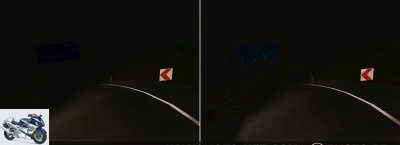
As an option and exclusively in the mid-displacement segment, the F900R can be equipped suspensions an electronically controlled shock absorber: its hydraulic "adapts automatically in the space of a thousandth of a second to given situations depending on the conditions and driving", assure the Germans.
Two settings are offered by this Dynamic ESA system: a "Road" more flexible and more oriented towards comfort and long distances, or a "Dynamic" more rigid and which allows a more sporty driving. The spring preload can also be managed with a button (long, stationary and engine running) on the same ESA button, depending on whether you are driving solo, duo loaded or not..
Instrumentation
Originally this time, the F900R receives the 6.5-inch color TFT screen present on the R1250 series (the bestseller GS but also the R roadster) and has the same BMW Motorrad connectivity. Complete and very legible, the display is controlled using the buttons installed on the left stalk and the ingenious "Multi Controller".
"When a smartphone and a helmet equipped with the BMW Motorrad communication system are linked via Bluetooth via the TFT screen, the rider can easily access the media playback and telephone functions", the manufacturer praised, "including the BMW Motorrad Connected app. free also offers very practical arrow navigation ".
“Further information and displays (angle take-off, braking force, stopwatch, etc.) are available with the optional equipment Riding Modes Pro,” adds BMW. Finally, the F900R can be equipped with rapid assistance in emergency situations "ecall" as well as the key system by transponder "Keyless Ride". For a fee, "naturlich" !
Related articles
-
Roadster – Yamaha MT-09 SP test: the one we SPEED! – MT-09 SP test page 3: Technical point
Yamaha MT-09 SP test: the one we Sought ! The Yamaha MT-09, one of the stars of the French motorcycle market, never ceases to enchant bikers eager for…
-
F900R test: the completely revised BMW roadster … with a dejà vu R BMW has just presented two major 2020 novelties to the international press: the…
-
Custom – BMW K1600B test: Power Bagger! – Page 3 – Technical point MNC K1600B
BMW K1600B test: Power Bagger ! The last BMW custom motorcycle, the R1200C discontinued in 2004, did not leave lasting memories … It is different for…
-
Road test – F900XR test: the new BMW Sport GT motorcycle – F900XR test page 3: Technical update
F900XR test: the new Sport GT BMW motorcycle In 2020, BMW stops the F800GT but does not abandon the segment of sporty road bikes of medium displacement….
-
Yamaha Niken test: trying the three-wheeled motorcycle is taming it ! For more than ten years, Yamaha engineers have been racking their brains to offer a…
-
Roadster – Test 790 Duke: KTM conquers bestselling roadsters – Test 790 Duke page 3: Technical point
790 Duke test: KTM takes on the bestselling roadsters KTM currently dominates the segment of maxisportifs maxiroadsters in France, thanks to its 1290…
-
Yamaha R1 and R1M 2020 test: hell of a blow … and salty extra cost ! Yamaha is taking advantage of the changeover to the Euro5 standard to perfect its…
-
Speed Triple RS test: the Triumph roadster raises the tone and the sound in 2018 Only two years after its last update, the Speed Triple benefits from…
-
Roadster – Test Honda CB1000R 2018: change of universe – Test CB1000R 2018 – Page 3: Technical point
2018 Honda CB1000R Test: Change of Universe Ten after making headlines, the Honda CB 1000 R is looking for a new style. Storing her modern influences in…
-
2017 Suzuki V-Strom 1000 XT test: a super cost ! The Suzuki V-Strom 1000 , relaunched in 2013 after a career suspension in 2008 due to Euro 3 standards,…